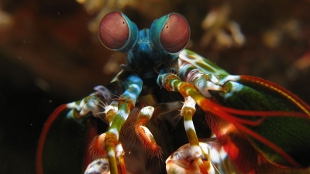 Odontodactylus scyllarus, a mantis shrimp species closely related to the one studied by Bok et al.WIKIMEDIA, PRILFISHMantis shrimp (Neogonodactylus oerstedii) have 16 different types of photoreceptors in their eyes, and six of them are ultraviolet (UV) receptors. According to a study published online in Current Biology on July 3, these specialized receptors are each spectrally tuned to a different ultraviolet frequency by overlying filters composed of various mycosporine-like amino acid (MAA) pigments, which are typically found in the skin of marine organisms and function to block harmful UV rays.
Odontodactylus scyllarus, a mantis shrimp species closely related to the one studied by Bok et al.WIKIMEDIA, PRILFISHMantis shrimp (Neogonodactylus oerstedii) have 16 different types of photoreceptors in their eyes, and six of them are ultraviolet (UV) receptors. According to a study published online in Current Biology on July 3, these specialized receptors are each spectrally tuned to a different ultraviolet frequency by overlying filters composed of various mycosporine-like amino acid (MAA) pigments, which are typically found in the skin of marine organisms and function to block harmful UV rays.
Researchers had found previously that mantis shrimp do not have better color vision than other animals that can sense color (humans typically have three color photoreceptors), but researchers Lund University in Sweden and the University of South Dakota have discovered that the crustaceans have a remarkable ability to sense UV light. Though mantis shrimp contain only...
Bok and his colleagues don’t know why mantis shrimp evolved such unique UV vision, but they propose that the predators may use the system to more effectively pick out prey hiding in the complex coral reef habitats they live in.
Interested in reading more?




